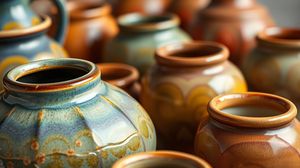
The Fulham Pottery Kiln, located at the junction of New King's Road and Burlington Road in London, stands as a testament to the city's rich industrial heritage. Established in 1672 by John Dwight, the Fulham Pottery was among the first in England to produce salt-glazed stoneware, significantly influencing the development of British ceramics.
The kiln itself is a distinctive bottle-shaped structure, characteristic of traditional pottery kilns of its era. Its unique design not only facilitated the efficient firing of ceramics but also became an iconic feature of the local landscape. Over the centuries, the pottery produced a wide range of items, from utilitarian wares to decorative pieces, contributing to both local and national markets.
Despite the passage of time and the evolution of the surrounding area, the Fulham Pottery Kiln remains a prominent historical landmark. It serves as a tangible link to London's artisanal past, offering insight into the craftsmanship and industrial practices of the 17th century. Today, the kiln stands as a symbol of the enduring legacy of London's pottery industry, inviting visitors to reflect on the city's rich cultural and industrial history.

Making the Most of Your Visit:
One quirky detail to keep an eye out for is the way the kiln's structure reflects the old-school construction techniques used in the 17th century. Spending a few extra minutes just observing its architecture can give you a real appreciation for the craftsmanship of that era.
If you're into photography, aim to visit on a sunny morning. The way the light hits the kiln at this time of day casts beautiful shadows that make for some stunning shots.
For a deeper dive into the pottery's history, head over to the nearby local library or bookshop, where you might find detailed accounts and books about London's industrial heritage. It's a great way to supplement your visit with some more historical context.
Check out the area right around the kiln—often there are small exhibitions or unique art installations nearby that can add an extra layer of interest to your visit.
Finally, after soaking in the kiln's fascinating history, enjoy a leisurely stroll along the Thames, which is just a stone's throw away. It's a pleasant way to reflect on the rich past of the area while enjoying some beautiful views.

Visiting Times & Costs:
The Fulham Pottery Kiln is accessible to the public for exterior viewing as a historical landmark. However, it is not typically open for entry or tours inside the kiln itself, and as such, there is no admission fee.
Opening Times: Since the kiln is an exterior structure, it can be viewed from the surrounding area at any time of day.
Cost: Free to view from the outside.
Accessibility: The area around the kiln is mostly flat and accessible, making it suitable for wheelchair users and those with limited mobility. However, as the kiln itself is not open for internal visits, accessibility inside is not applicable.
Nearby Facilities: Public seating and access to the Thames Path are nearby, allowing for a comfortable visit and a pleasant walking area.

Address & Map:

Nearby:























